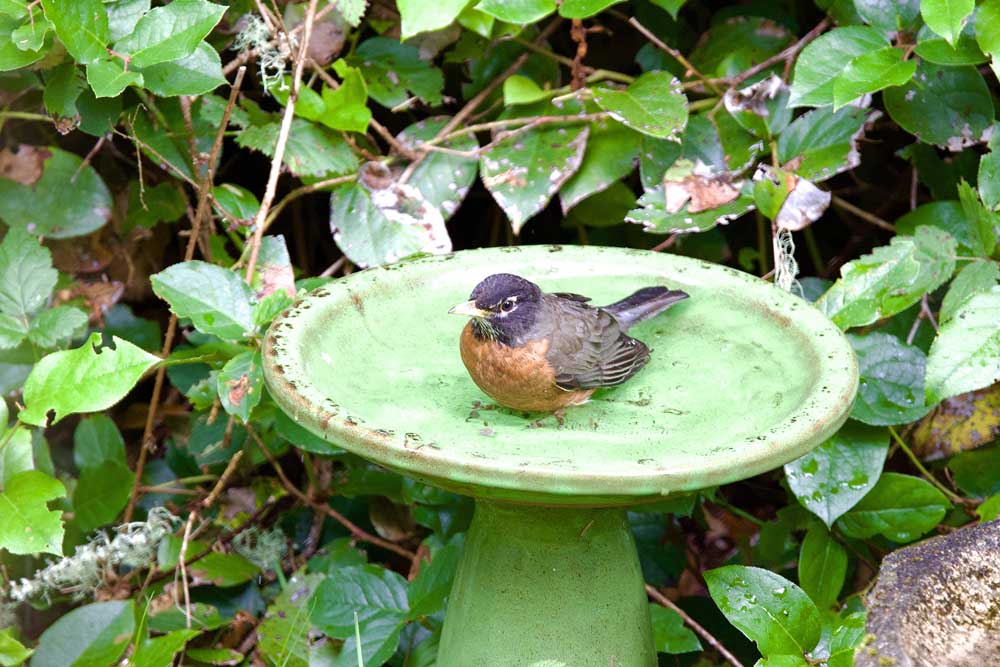Birding: Backyard antics, lists and a watchful eye continued
Published 11:05 am Thursday, August 18, 2022

- The American robin is a bird bath bully!
Keeping tabs on my feathered friends is one of the past times that I enjoy most. This story on birding is a continuation of what my watchful eyes, camera and notebooks have recorded of late.
Trending
The increase in the number of individuals birds in the yard is partially due to a successful breeding season especially for the purple finch, chickadees and the song sparrows. Juvenile purple finches dominate the feeders, while the song sparrows dominate the bird baths. In fact, three song sparrows and one American robin have each been taking a position on occasion on one of the four bird baths and all at the same time. They sit on the rim or like the robin, in the middle. Their posture is designed to intimidate any other bird who is bold enough to venture near. One particularly feisty, orange-crowned warbler, however, was not intimidated by their posturing. It successfully chased the four bath hogs away, a mighty task for such a tiny bird. There are times when the orange-crowned loses the show down, then it simply nips into the salal behind the baths only to come out on the bath behind the robin who is guarding from the middle. The robin seems oblivious to its presence. In spite of it all, the orange-crowned foiled the bird bath bullies.
The increase in the number of individuals birds in the yard is partially due to a successful breeding season especially for the purple finch, chickadees and the song sparrows.
Do you ever see an Anna’s or the Rufous hummingbird harassing the seed feeder birds or birds in the bath when they want a turn? Mine do! It is a sight to behold. Rufous hummingbirds have been observed harassing both the pine siskins and purple finch. Their tactic consists of hovering over and behind them. There are a lot them, and they sit on the feeder all day. There are the bath hogs and feeder hogs in my yard. It is interesting, though, that the hummers do not bother the chickadees. But then they aren’t feeder hogs either.
There have been two red-tailed hawks hanging around the conifers on the edge of the meadow out front. They usually sit high in a Sitka spruce looking out across the wetland with its waving golden grasses and pickle weed toward Willapa Bay. It is a wetland and home to small mammals and amphibians. One of the red-tails has been dubbed the “cry baby” because it literally whined nearly all day long. It appears to be a juvenile begging for something to eat! It’s whining matches the call of a red-tail juvenile begging call according to Merlin, the ID app. Its carry on lasted for two weeks.
As mentioned earlier, the purple finches have been hogging the black oil seed feeders all summer. According to my notes from other summers there has usually been only one or two adult pairs in the yard, and they weren’t seen every day. This year there is an abundance of young birds all of whom get up at the crack of dawn to have breakfast. During the day they are joined by the pine siskins and American goldfinches. If these interlopers don’t stay too long, their presence is tolerated.
To my surprise only one Steller’s jay has been a daily visitor. Normally there would be at least half a dozen. Peanuts in the shell haven’t been on the menu for a while. This may explain why other jays are not interested in the yard this summer.
The Indy 500 takes place all day in the yard. The hummers play “keep away” Whenever a fellow hummingbird wanders into its area for a bit of nectar from the feeder or to rest on a black berry vine or the huckleberry bushes. The chase is exhilarating to watch. Zip, zip is always music to my ears.
Following the collapse of a particular dead snag (its favorite) in the yard the olive-sided flycatcher became a non-resident. It appears to have moved to the property next door, but yesterday it popped by for a drink of fresh water. I am sure it was attracted by the water wiggling away in the bird bath. Afterwards, it perched on a sitka spruce branch with its back to me. I could see one of the white ovals located on the sides of the rump. They are rarely visible but are an important ID marker. The olive-sided flycatcher’s call sounds like “hic three beers” to me. I haven’t heard it recently but now that it has found a fresh water source perhaps it will come into the yard more frequently and sing to let me know it has returned.
Last, but not least, I have the latest on Lady Junco. Shelley reports that she raised three broods in the Hosta Hotel. The third nest contained four eggs, but only two hatched. Both nestlings fledged successfully and made their way to safety. To our knowledge, this is the first time Lady Junco has had three broods. The Hosta Hotel did a good business this year!
The stories about bird antics and behavior in the yard continue to materialize under my watchful eye. I wonder what fall and winter will bring. No matter what, it is bound to be exciting.
Happy birding!









